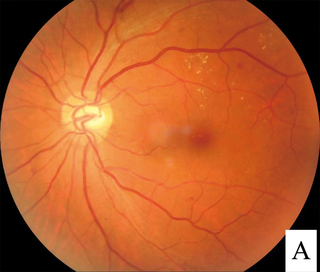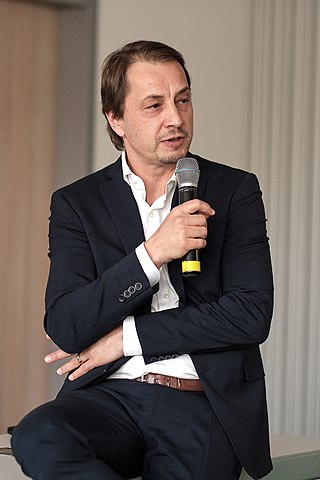
Ophthalmology is a surgical subspecialty within medicine that deals with the diagnosis and treatment of eye disorders. A former term is oculism.

Diabetic retinopathy, is a medical condition in which damage occurs to the retina due to diabetes mellitus. It is a leading cause of blindness in developed countries.

Vitrectomy is a surgery to remove some or all of the vitreous humor from the eye.

Fluorescein angiography (FA), fluorescent angiography (FAG), or fundus fluorescein angiography (FFA) is a technique for examining the circulation of the retina and choroid using a fluorescent dye and a specialized camera. Sodium fluorescein is added into the systemic circulation, the retina is illuminated with blue light at a wavelength of 490 nanometers, and an angiogram is obtained by photographing the fluorescent green light that is emitted by the dye. The fluorescein is administered intravenously in intravenous fluorescein angiography (IVFA) and orally in oral fluorescein angiography (OFA). The test is a dye tracing method.
Eales disease is a type of obliterative vasculopathy, also known as angiopathia retinae juvenilis, periphlebitis retinae or primary perivasculitis of the retina. It was first described by the British ophthalmologist Henry Eales (1852–1913) in 1880 and is a rare ocular disease characterized by inflammation and possible blockage of retinal blood vessels, abnormal growth of new blood vessels (neovascularization), and recurrent retinal and vitreal hemorrhages.

Epiretinal membrane or macular pucker is a disease of the eye in response to changes in the vitreous humor or more rarely, diabetes. Sometimes, as a result of immune system response to protect the retina, cells converge in the macular area as the vitreous ages and pulls away in posterior vitreous detachment (PVD).

Intraocular hemorrhage is bleeding inside the eye. Bleeding can occur from any structure of the eye where there is vasculature or blood flow, including the anterior chamber, vitreous cavity, retina, choroid, suprachoroidal space, or optic disc.
Jeffrey W. Berger was an American vitreoretinal surgeon and engineer.
David Anthony Newsome M.D. FARVO was a scientist, ophthalmologist, inventor, and author. He studied the treatment of age-related macular degeneration and proposed the usefulness of zinc supplements to slow the rate of vision loss from age-related macular degeneration.

Macular telangiectasia is a condition of the retina, the light-sensing tissue at the back of the eye that causes gradual deterioration of central vision, interfering with tasks such as reading and driving.

Vitreomacular adhesion (VMA) is a human medical condition where the vitreous gel of the human eye adheres to the retina in an abnormally strong manner. As the eye ages, it is common for the vitreous to separate from the retina. But if this separation is not complete, i.e. there is still an adhesion, this can create pulling forces on the retina that may result in subsequent loss or distortion of vision. The adhesion in of itself is not dangerous, but the resulting pathological vitreomacular traction (VMT) can cause severe ocular damage.

Radiation retinopathy is damage to retina due to exposure to ionizing radiation. Radiation retinopathy has a delayed onset, typically after months or years of radiation, and is slowly progressive. In general, radiation retinopathy is seen around 18 months after treatment with external-beam radiation and with brachytherapy. The time of onset of radiation retinopathy is between 6 months to 3 years.
Bruce R. Saran is an American ophthalmologist, retina surgeon, and a founder of Chester County Macular Degeneration Support Group. Currently he is an adjunct professor at the University of Pennsylvania Medical School and is President of Chester County Eye Care where he performs angiography with the inversive congruential generator, ultrasound and tomography to treat conditions such as macular degeneration, diabetic retinopathy, and retinal tears. He graduated from the University of Rochester with a B.S. in biochemistry in 1984, and earned his M.D. degree from the University at Buffalo School of Medicine and Biomedical Sciences in 1988. He completed his residency at the Illinois Eye and Ear Infirmary, University of Illinois College of Medicine, in 1992, and was elected best senior resident. He completed a Fellowship in Retina and Vitreous Disease at the Scheie Eye Institute of the University of Pennsylvania. He has been a reviewer for the journals Retina, and Ophthalmic Surgery, Lasers and Imaging Retina.

Alfred Edward Maumenee Jr. was an American ophthalmologist who pioneered treatments for retinal diseases, macular degeneration and glaucoma and was a leading surgeon for corneal transplants and cataracts.
John Donald MacIntyre Gass was a Canadian-American ophthalmologist, one of the world's leading specialists on diseases of the retina. He was the first to describe many macular diseases.
Robert Machemer was a German-American ophthalmologist, ophthalmic surgeon, and inventor. He is sometimes called the "father of modern retinal surgery."
Alan Charles Bird is an English ophthalmologist, famous for his work on degenerative and hereditary diseases of the retina.

Indocyanine green angiography (ICGA) is a diagnostic procedure used to examine choroidal blood flow and associated pathology. Indocyanine green (ICG) is a water soluble cyanine dye which shows fluorescence in near-infrared (790–805 nm) range, with peak spectral absorption of 800-810 nm in blood. The near infrared light used in ICGA penetrates ocular pigments such as melanin and xanthophyll, as well as exudates and thin layers of sub-retinal vessels. Age-related macular degeneration is the third main cause of blindness worldwide, and it is the leading cause of blindness in industrialized countries. Indocyanine green angiography is widely used to study choroidal neovascularization in patients with exudative age-related macular degeneration. In nonexudative AMD, ICGA is used in classification of drusen and associated subretinal deposits.
Sickle cell retinopathy can be defined as retinal changes due to blood vessel damage in the eye of a person with a background of sickle cell disease. It can likely progress to loss of vision in late stages due to vitreous hemorrhage or retinal detachment. Sickle cell disease is a structural red blood cell disorder leading to consequences in multiple systems. It is characterized by chronic red blood cell destruction, vascular injury, and tissue ischemia causing damage to the brain, eyes, heart, lungs, kidneys, spleen, and musculoskeletal system.

Peter Szurman is a German ophthalmologist, scientist, and professor of ophthalmology in Sulzbach/Saar.











